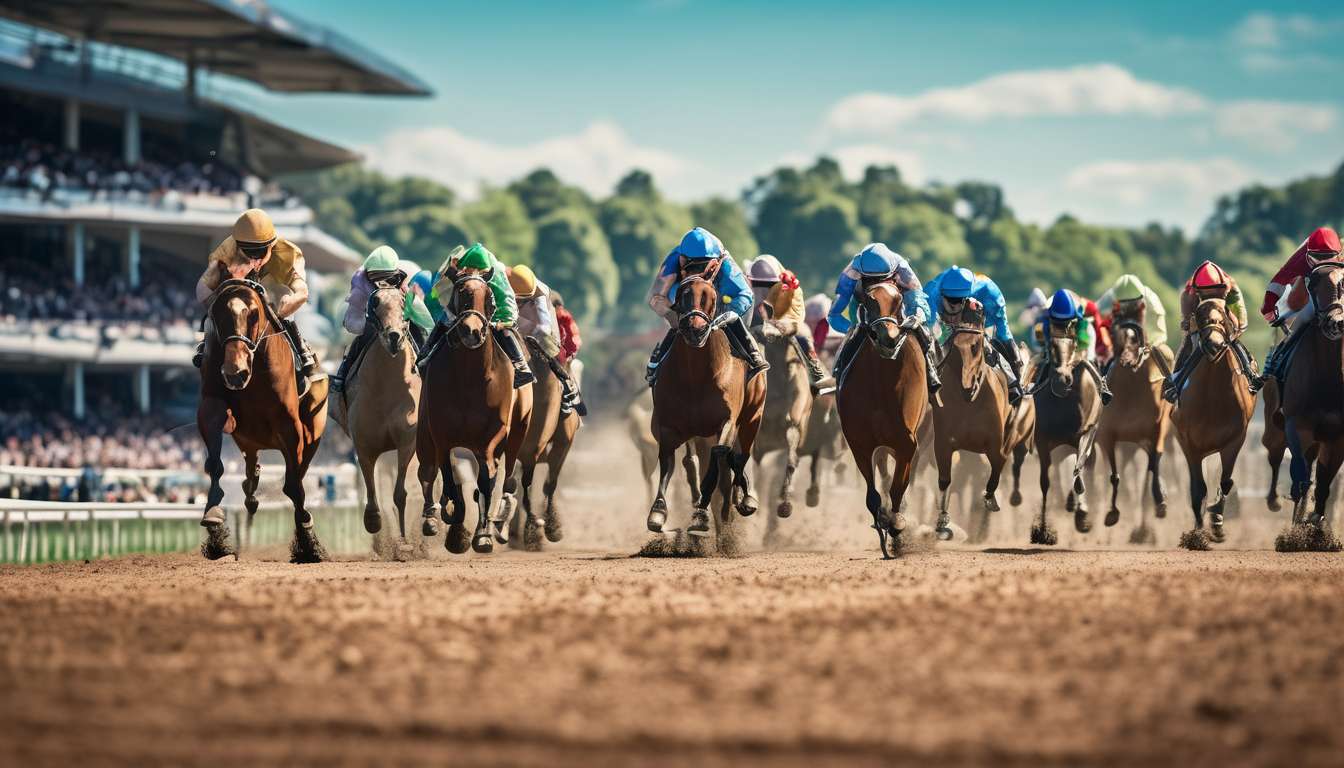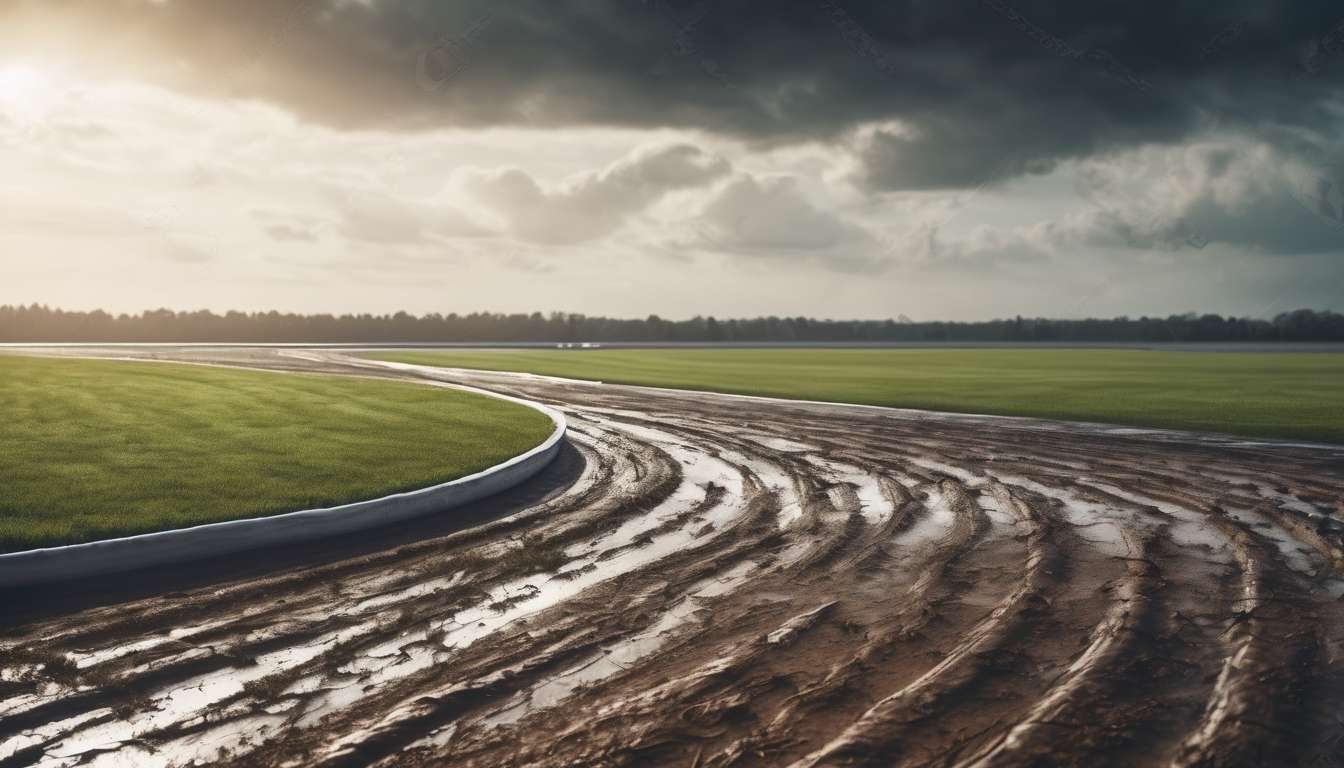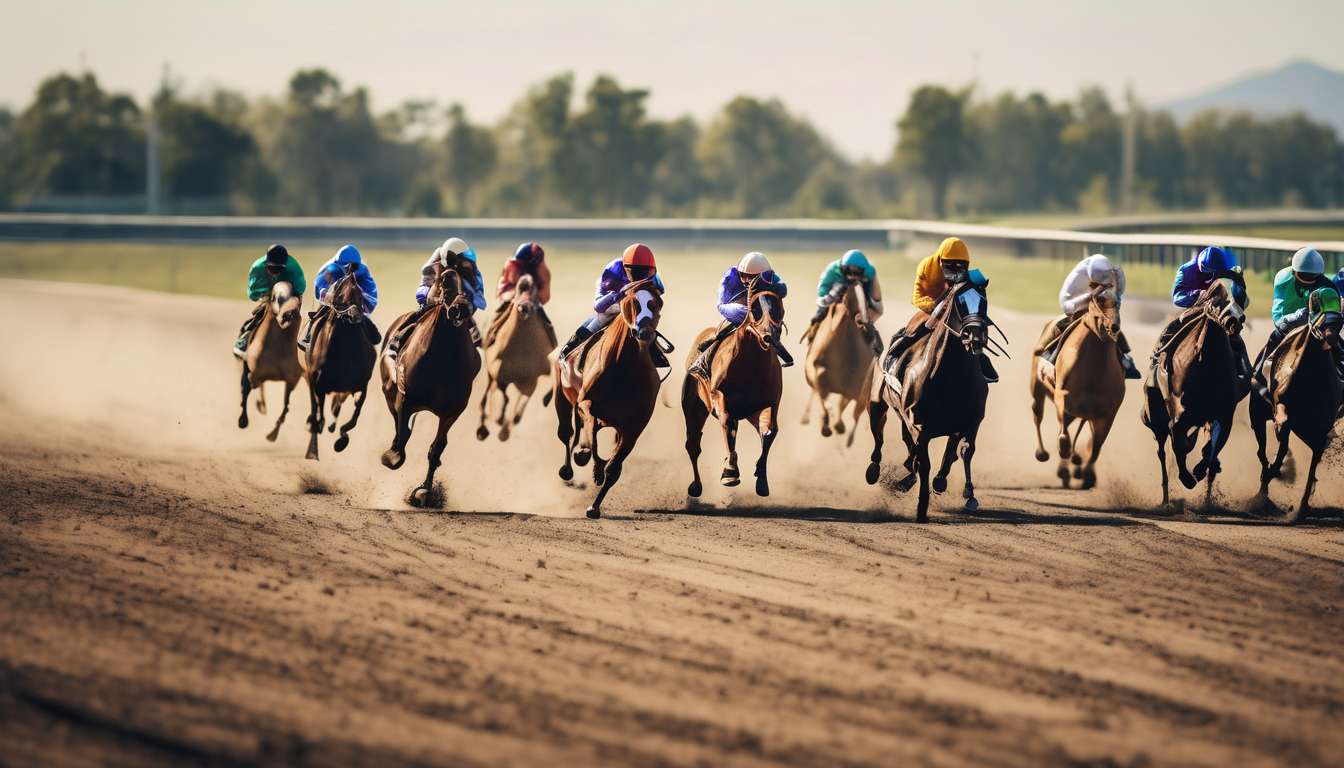As seasoned enthusiasts of the racing world, we often find ourselves engrossed in the dynamic interplay between turf and dirt tracks. This fascination stems from the distinct characteristics each surface brings to the sport, influencing not only the strategies of trainers and jockeys but also the outcomes of the races themselves.
Our collective passion for understanding these nuances has led us to explore nine analytical angles that offer deeper insights into how these surfaces impact performance:
-
Physical Attributes: Examining the physical attributes required for horses to excel on different tracks.
-
Historical Trends: Understanding the historical trends and patterns that have emerged over years of competition.
-
Surface Characteristics: Analyzing the specific characteristics of turf versus dirt surfaces.
-
Training Techniques: Exploring how training techniques differ based on the track surface.
-
Jockey Strategies: Investigating how jockey strategies are adapted for each type of track.
-
Horse Performance: Assessing horse performance metrics across different surfaces.
-
Betting Patterns: Studying how betting patterns shift with track surface changes.
-
Weather Impact: Evaluating how weather conditions affect each type of track.
-
Injury Rates: Reviewing injury rates associated with turf versus dirt tracks.
By delving into these perspectives, we hope to enhance our appreciation and strategic approach to betting and spectating. Bringing a more informed viewpoint to our shared enjoyment of this thrilling sport will undoubtedly enrich our experiences and discussions within the racing community.
Physical Requirements
Turf and dirt races demand distinct physical attributes from racehorses, influencing their training and performance.
As a community that shares a passion for racing, we know that understanding these differences helps us appreciate each race’s unique dynamics. The surface plays a significant role in shaping a horse’s performance:
-
Turf: With its softer, grass-covered ground, it typically requires horses with strong hindquarters and agility to navigate tighter turns and varying terrain.
-
Dirt: These tracks often favor horses with robust cardiovascular capacity and endurance, as they need to maintain speed on a harder, more consistent surface.
Weather conditions further impact these surfaces and, consequently, the horses’ performance.
-
Rain can turn turf courses slick and challenging, demanding adaptability and sure-footedness.
-
Conversely, dirt tracks may become muddy, testing a horse’s stamina and resilience.
Together, these factors highlight the importance of adapting training regimens to fit the surface and weather, fostering a deeper connection with the intricacies of this beloved sport.
Historical Analysis
Over the years, we’ve seen how the evolution of racing surfaces has shaped the strategies and outcomes of turf and dirt races.
As a community, we’ve witnessed how the choice of surface directly impacts a horse’s performance and the jockey’s tactics. Historically, dirt tracks offered consistency, but turf tracks introduced a new dynamic affected by weather conditions. Rain or shine, the surface dictates how a race unfolds, influencing everything from speed to endurance.
In our shared racing history, certain patterns emerge:
-
During wet weather, turf becomes softer, often favoring horses with strong stamina.
-
Conversely, a dry, firm surface might see speedier runners excel.
-
On dirt, weather plays a role too, turning tracks from fast to muddy, altering race dynamics.
Our understanding of these elements has deepened our appreciation for the strategic nuances involved in racing.
By analyzing historical performances, we gain insights, fostering a sense of unity and belonging among enthusiasts who cherish these timeless traditions.
Surface Comparison
We’re diving into the nuanced differences between turf and dirt tracks to understand how each surface uniquely influences race outcomes. As enthusiasts, we know that the surface can drastically affect a horse’s performance, and it’s something we can’t overlook.
Turf Tracks:
- Often softer and more forgiving.
- Tend to favor horses with a lighter stride.
Dirt Tracks:
- Firmer and can enhance speed.
- May require more stamina.
Weather Influence:
Weather plays a significant role in race dynamics:
- Rain on Turf: Can turn it into a softer, energy-sapping surface.
- Rain on Dirt: Can make it muddy and heavy.
We’ve observed that:
- Some horses thrive on wet surfaces.
- Others struggle, emphasizing the importance of knowing a horse’s surface preference and adaptability.
Belonging to this community means understanding these subtleties, which allows us to appreciate and predict race outcomes better.
Let’s continue to deepen our insights by considering these elements, as they’re crucial in evaluating every race we watch or analyze.
Training Variances
Training Methods for Turf and Dirt Races
Training methods vary significantly between turf and dirt races, shaping how horses develop their strengths and strategies for optimal performance. As a community of racing enthusiasts, we recognize that the surface plays a crucial role in determining the training approach.
Turf Tracks:
- Typically softer
- Require horses to focus on agility and balance
Dirt Tracks:
- Emphasize speed and endurance
These differences ensure that our training programs are tailored to accentuate each horse’s natural abilities.
Impact of Weather Conditions
Weather conditions further influence our strategies:
-
Turf Tracks:
- Wet weather can alter the ground’s firmness.
- Impacts a horse’s grip and necessitates a shift in training focus.
-
Dirt Tracks:
- Can become heavier or lighter depending on moisture levels.
- Affects speed and stamina.
We must adapt our training regimens to prepare our horses for these variations, ensuring consistent performance regardless of the elements.
Enhancing Competitive Edge
By understanding these training variances, we strengthen our connection to the sport and enhance our horses’ competitive edge. Together, we navigate the complexities of racing to achieve success.
Jockey Adaptation
Jockeys must adeptly adjust their riding techniques to match the distinct demands of turf and dirt tracks.
As we navigate these racing surfaces, our strategy and skills need to be as adaptable as the weather.
On Turf Tracks:
- We often face softer surfaces that demand precision and balance, especially in damp conditions.
- A controlled ride ensures optimal performance, as turf can quickly shift underfoot.
- It requires us to remain alert and responsive to the changing conditions.
On Dirt Tracks:
- Typically, a more aggressive approach is necessary.
- The compact surface allows for greater speed but can kick up dust and debris, impacting visibility.
- We work to maintain momentum and position.
- Understanding that weather can alter the track’s hardness and slipperiness, we adjust to affect our mount’s grip.
By adjusting our techniques to the surface and weather conditions, we enhance not only our performance but also the horse’s. This adaptability cements our place in a community that thrives on shared success.
Together, we embrace the challenges and triumphs of each race.
Performance Metrics
Accurate performance metrics allow us to evaluate how effectively we adapt our strategies on different racing surfaces. By examining these metrics, we can truly feel part of a knowledgeable community that masters the intricacies of racing.
Our performance often hinges on understanding how horses respond to varying surfaces—turf or dirt—under different weather conditions. Each surface presents unique challenges, and tracking our performance on each helps us make informed decisions.
Weather plays a significant role in influencing race outcomes and, consequently, our strategies.
- Wet conditions can alter a dirt track’s consistency.
- Turf races might see a change in pace with the slightest shift in weather.
By analyzing past performances under varied weather conditions, we’re better equipped to predict how current races might unfold.
This shared understanding strengthens our collective experience and fosters a sense of unity among us as we navigate the complex world of turf and dirt racing, always learning and improving together.
Wagering Behavior
In our exploration of wagering behavior, we notice how bettors’ confidence often fluctuates based on the nuances of turf and dirt tracks. The surface plays a pivotal role in shaping expectations and strategies.
When placing bets, it is crucial to consider the performance history of horses on different surfaces:
- Some horses excel on turf.
- Others thrive on dirt.
Knowing this can give us an edge.
As a community, we share insights and observations, creating a collective wisdom that guides our decisions. Performance isn’t only about individual horses; it’s about understanding the broader trends and patterns in play.
We often discuss how weather conditions might affect the race and the surface, although a deeper dive into this topic will be saved for later.
Together, we cultivate a sense of belonging as we navigate the complex world of horse racing. By sharing our experiences and knowledge, we strengthen our community and enhance our wagering strategies.
Weather Influence
As we delve into the influence of weather on racing outcomes, it’s clear that even slight changes in conditions can dramatically impact track surfaces and horse performance. Whether it’s a sudden downpour or a dry spell, the surface of the track can shift, affecting how horses run and how we as a community anticipate the race results.
In turf racing, rain can transform a firm surface into a soft, yielding one, altering the performance dynamics significantly.
- Horses that excel on softer ground may suddenly have an edge.
- Horses accustomed to firmer surfaces might struggle.
On dirt tracks, rain can lead to a muddy surface, which tends to favor:
- Horses with stamina.
- Those who can handle such conditions.
By keeping a close eye on weather forecasts, we can better predict how these changes will influence race outcomes. Our shared knowledge and insights on weather’s impact allow us to make more informed decisions, strengthening our sense of belonging within the racing community.
What are the common injuries associated with turf and dirt racing?
Common Injuries in Turf and Dirt Racing
In horse racing, the type of track surface can significantly influence the types of injuries horses may suffer:
-
Turf Racing
- Horses often face tendon strains due to the softer surface.
-
Dirt Racing
- Issues like hoof bruising and joint problems are more prevalent.
Importance of Monitoring
It is crucial for trainers and veterinarians to closely monitor these risks to ensure the well-being of our equine athletes.
Prevention and Attention
By being proactive and attentive, we can help prevent and address these injuries promptly for the benefit of our beloved horses.
How do breeding practices differ for horses that primarily race on turf versus dirt?
Breeding Practices for Horses
Breeding practices for horses vary depending on the primary racing surface—turf or dirt. Breeders focus on different traits to enhance performance on each type of surface.
Turf Racing Traits
- Endurance
- Agility
Dirt Racing Traits
- Speed
- Power
Optimization Strategies
By tailoring bloodlines and training methods to these specific traits, breeders can optimize a horse’s potential for success in its specific racing environment.
What are the nutritional needs for horses running on different surfaces?
We’ve found that horses running on different surfaces have varying nutritional needs.
Turf Racers:
- Often require more iron and potassium.
- The softer ground impact and increased muscle exertion are key reasons for this need.
Dirt Racers:
- May benefit from higher levels of copper and zinc.
- These nutrients support hoof and bone strength on firmer tracks.
Conclusion:
Understanding these differences helps us tailor our feeding programs to best support our horses’ performance and well-being.
Conclusion
In conclusion, analyzing the various angles between turf and dirt races can provide valuable insights for both bettors and horse racing enthusiasts.
By considering factors such as:
- Physical requirements
- Historical data
- Weather influences
you can make more informed decisions when wagering on races.
Understanding the differences in:
- Training
- Jockey adaptation
- Performance metrics
can give you a competitive edge in predicting race outcomes.
Stay sharp and keep exploring these analytical angles to enhance your enjoyment and success in horse racing.




